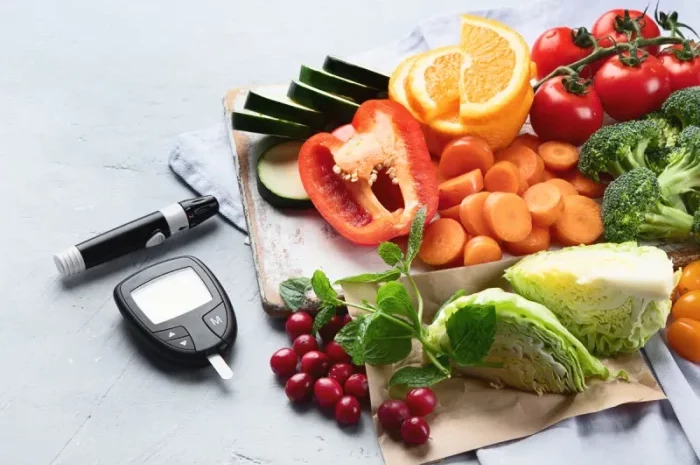Diabetes is a chronic condition that affects millions of people worldwide. It occurs when the body cannot effectively regulate blood sugar (glucose) levels. There are two main types of diabetes: Type 1, where the body’s immune system attacks insulin-producing cells in the pancreas, and Type 2, where the body becomes resistant to insulin or doesn’t produce enough. A third, less common form is gestational diabetes, which occurs during pregnancy.
A key aspect of managing diabetes is diet. A balanced diet helps maintain blood glucose levels, manage weight, and reduce the risk of complications. Vegetables, in particular, play a crucial role in a diabetes-friendly diet. They provide essential nutrients, fiber, and antioxidants, contributing to overall health and well-being.
Nutritional Benefits of Vegetables
Vegetables are low in calories and high in essential vitamins, minerals, and fiber. Here’s a breakdown of why these components are beneficial:
1. Vitamins and Minerals
Vegetables are packed with vitamins and minerals that support various bodily functions. For example, leafy greens like spinach and kale are rich in vitamin K, which is important for blood clotting and bone health. Bell peppers and broccoli are high in vitamin C, an antioxidant that supports the immune system and skin health.
2. Fiber
Dietary fiber, found abundantly in vegetables, is crucial for diabetes management. Fiber slows down the digestion and absorption of carbohydrates, preventing spikes in blood sugar levels. Soluble fiber, found in foods like carrots, peas, and Brussels sprouts, can help lower blood glucose levels. Insoluble fiber, found in vegetables like cauliflower and green beans, aids in digestion and prevents constipation.
3. Antioxidants
Vegetables are a rich source of antioxidants, which combat oxidative stress and inflammation. Oxidative stress can lead to cell damage and has been linked to diabetes complications. Antioxidants like beta-carotene (found in carrots and sweet potatoes), lutein (in green leafy vegetables), and lycopene (in tomatoes) play a protective role.
Glycemic Index and Glycemic Load
The glycemic index (GI) measures how quickly a food raises blood glucose levels. Foods with a high GI cause rapid spikes in blood sugar, while low-GI foods have a slower, more gradual effect. Most vegetables have a low to moderate GI, making them ideal for a diabetes-friendly diet.
Glycemic Load (GL)
Glycemic load takes into account both the GI and the carbohydrate content in a serving of food. It provides a more accurate representation of a food’s impact on blood sugar levels. Non-starchy vegetables, such as leafy greens, broccoli, and cucumbers, typically have a low GL, meaning they are excellent choices for maintaining stable blood sugar levels.
Types of Vegetables Beneficial for Diabetes
1. Leafy Greens
Leafy greens like spinach, kale, and Swiss chard are nutrient-dense and low in calories. They are rich in vitamins A, C, and K, as well as folate, calcium, and iron. Their high fiber content helps manage blood sugar levels and promotes a feeling of fullness.
2. Cruciferous Vegetables
Cruciferous vegetables include broccoli, cauliflower, Brussels sprouts, and cabbage. These vegetables are known for their cancer-fighting properties and are high in fiber and antioxidants. They also contain compounds like sulforaphane, which has been shown to have anti-diabetic effects.
3. Root Vegetables
Root vegetables such as carrots, beets, and turnips are nutritious and can be included in a diabetes diet in moderation. They provide fiber, vitamins, and minerals. Although they have a higher carbohydrate content than leafy greens, their fiber content helps moderate blood sugar impact.
4. Legumes
Legumes, including beans, lentils, and peas, are excellent sources of protein and fiber. They have a low GI and can help stabilize blood sugar levels. Additionally, legumes are rich in iron, magnesium, and potassium, which are beneficial for overall health.
5. Alliums
Allium vegetables like onions, garlic, and leeks offer numerous health benefits. They contain compounds like allicin, which has anti-inflammatory and antioxidant properties. These vegetables can help improve blood circulation and support heart health, which is crucial for people with diabetes.
Incorporating Vegetables into a Diabetes Diet
1. Meal Planning
Planning meals around vegetables can help ensure a balanced diet. Aim to fill half your plate with non-starchy vegetables, a quarter with lean protein, and a quarter with whole grains or starchy vegetables. This approach, known as the “plate method,” helps control portion sizes and maintain balanced blood sugar levels.
2. Cooking Methods
How vegetables are prepared can impact their nutritional value. Steaming, roasting, grilling, and sautéing with healthy oils (like olive oil) are great methods. Avoid deep-frying or cooking vegetables in heavy sauces, which can add unnecessary calories and fat.
3. Variety and Seasonality
Eating a variety of vegetables ensures a broad spectrum of nutrients. Seasonal vegetables are often fresher and more nutritious. Experimenting with different types of vegetables and cooking methods can make meals more enjoyable and prevent dietary monotony.
The Role of Vegetables in Weight Management
Weight management is crucial for people with Type 2 diabetes, as excess weight can increase insulin resistance. Vegetables are low in calories and high in fiber, making them ideal for weight loss and maintenance. High-fiber foods promote satiety, reducing overall calorie intake and helping with weight control.
Low-Calorie Density
Vegetables have a low calorie density, meaning they provide fewer calories per gram compared to other food groups. This allows for larger portions without significantly increasing calorie intake, helping to maintain a healthy weight.
Vegetables and Cardiovascular Health
People with diabetes are at higher risk for cardiovascular disease. Vegetables support heart health in several ways:
1. Blood Pressure Regulation
Potassium-rich vegetables like spinach, sweet potatoes, and tomatoes help regulate blood pressure by balancing sodium levels in the body.
2. Cholesterol Management
Soluble fiber found in vegetables like carrots, Brussels sprouts, and legumes can help lower LDL (bad) cholesterol levels. This reduces the risk of plaque buildup in the arteries, promoting better heart health.
3. Anti-Inflammatory Properties
Chronic inflammation is a risk factor for heart disease. Vegetables with anti-inflammatory properties, such as tomatoes, leafy greens, and cruciferous vegetables, help reduce inflammation and support cardiovascular health.
Vegetables and Blood Sugar Control
Maintaining stable blood sugar levels is the cornerstone of diabetes management. Vegetables play a critical role in achieving this goal.
1. Slow Carbohydrate Absorption
Fiber-rich vegetables slow down the absorption of carbohydrates, preventing rapid spikes in blood sugar levels. This is particularly important after meals when blood sugar levels tend to rise.
2. Insulin Sensitivity
Some vegetables, like broccoli and Brussels sprouts, contain compounds that can improve insulin sensitivity. Better insulin sensitivity allows the body to use glucose more effectively, reducing the need for external insulin or medications.
3. Satiety and Reduced Caloric Intake
By promoting a feeling of fullness, vegetables help control hunger and reduce overall caloric intake. This is beneficial for maintaining a healthy weight and managing blood sugar levels.
Addressing Common Myths about Vegetables and Diabetes
Myth 1: Starchy Vegetables Are Bad for Diabetes
While starchy vegetables like potatoes, corn, and peas have a higher carbohydrate content, they can still be part of a balanced diet. Portion control and pairing them with non-starchy vegetables and protein can help manage their impact on blood sugar levels.
Myth 2: Raw Vegetables Are Always Better
Both raw and cooked vegetables have their benefits. Cooking can increase the bioavailability of certain nutrients, such as beta-carotene in carrots and lycopene in tomatoes. A mix of raw and cooked vegetables ensures a diverse intake of nutrients.
Myth 3: All Green Vegetables Are Low in Carbohydrates
While most green vegetables are low in carbohydrates, some, like peas and green beans, have a higher carbohydrate content. It’s important to be mindful of portion sizes and the overall carbohydrate content of meals.
Practical Tips for Increasing Vegetable Intake
1. Start Small
Incorporate vegetables into meals gradually. Add them to soups, stews, casseroles, and smoothies. Start with familiar vegetables and gradually introduce new ones.
2. Make Vegetables Convenient
Keep pre-washed and cut vegetables in the fridge for easy snacking and meal prep. Frozen vegetables are also a convenient and nutritious option.
3. Experiment with Recipes
Explore new recipes that highlight vegetables. Try stir-fries, salads, vegetable-based soups, and roasted vegetable dishes. Using herbs and spices can enhance the flavor of vegetable dishes.
4. Grow Your Own
If possible, growing your own vegetables can be rewarding and ensure a fresh supply. Even a small garden or container gardening can provide a variety of vegetables.
See also: Optimal Meal Frequency for Diabetics: How Often Should You Eat?
Conclusion
Vegetables are a cornerstone of a healthy diet for managing diabetes. Their rich nutritional profile, low glycemic index, and numerous health benefits make them indispensable for blood sugar control, weight management, and overall health. Incorporating a variety of vegetables into daily meals can significantly improve the quality of life for people with diabetes and reduce the risk of complications. By understanding the importance of vegetables and finding practical ways to include them in the diet, individuals can take proactive steps towards better diabetes management and enhanced well-being.
Related topics:
How Many Carbs Should a Diabetic Eat for Breakfast?

























